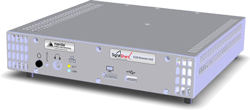
Narda Safety Test Solutions has released a remote-controlled version of its SignalShark signal analyzer, offering flexibility, reliability and an attractive price/performance ratio. The new SignalShark Remote Analyzer detects, analyzes, classifies and localizes RF signals between 8 kHz and 8 GHz. With 40 MHz real-time bandwidth, the Remote Analyzer can detect pulsed signals down to 3.125 µs with 100 percent probability of intercept. Its output is a 20 MHz stream of 16-bit I/Q data, which is compliant with the VITA 49 standard. In spectrum mode, the scan rate of up to 50 GHz/s ensures signals are captured, even when sweeping large frequency bands. The real-time spectrum, spectrogram and persistence analysis functions enable all captured signals to be analyzed with exceptionally high resolution in both time and frequency (see Figure 1).

Figure 1 The SignalShark Remote Analyzer has the same graphical user interface as the SignalShark Handheld, so remote control software is not essential; a remote desktop application is sufficient.
Judging by its specifications, the Remote Analyzer is equal to the powerful handheld SignalShark from which it was derived. The remote unit has been modified and optimized for applications requiring efficient, centrally-controlled monitoring, where the analyzers may be widely spaced over a large area. The measurement core of the Remote Analyzer is identical to the handheld SignalShark. It adds four switchable RF inputs, enabling several antennas to be connected covering different directions or frequency ranges. This eliminates the need for a complex, external switch to connect multiple antennas to a conventional analyzer with a single RF input.
The internal computer running Windows 10 evaluates the measurement data and ensures that only processed, relevant data is passed back to the control center - irregularities in the spectrum being observed, for example. The remote unit handles the monitoring tasks on site, using far less bandwidth than sending all signals back to the control center. 99.99 percent of the time, there is no interference and central processing is not required. The remote device is easily accessed whenever needed, to review results for the past 24 hours, for example.
The Remote Analyzer can be operated with an antenna for automatic direction finding and time difference of arrival, techniques used with several spectrum monitoring stations to localize interfering signals in urban areas. One automatic antenna can determine the bearing of an interference source; at least two antennas at different locations are required to determine the position by triangulation. SignalShark Remote Analyzers can be located on top of buildings at several locations, each equipped with an independent power supply, solar cells and a back-up battery. When an interfering signal is detected, the data from the remote units is passed back to the system operator’s computer via an LTE modem and the cellular network, where the system operator can identify the location of the interfering signal.
To support the full range of centralized monitoring, analysis and direction finding functions from a remote location, the monitoring receiver must be ITU compliant, have good time resolution - including absolute time mapping by GPS synchronization - and be fully remote-controlled with a standardized data transfer protocol. The SignalShark Remote Analyzer uses the Standard Commands for Programmable Instruments remote control language and VITA 49 streaming, which facilitates integration in a network, simplifies development of drivers and ensures the data can be understood by any software. Running on the Windows 10 platform means the Remote Analyzer will run third-party applications, offering users the flexibility to handle an almost unlimited range of spectrum monitoring applications.

Figure 2 The Remote Analyzer can be used free standing or mounted in a standard rack for fixed installations.
The modular design of the unit, with an aluminum casing and weighing just 2.1 kg, is a further advantage for its versatility, as it can be used free standing. In this mode, the USB ports enable a keyboard and display to be connected. Installed for stationary use, several Remote Analyzers can be installed in a 19 in. rack - in a 1U high double horizontal configuration (see Figure 2) or one above the other (2U high), for example. Using two or more analyzers in the same rack is effective and economical for monitoring larger bandwidths, as several analyzers are considerably cheaper than a single high-end device, and they can be scaled and cascaded to cover the required frequency range. For example, the first unit might cover 360 to 400 MHz, the second from 400 to 440 MHz.
The advantages of the SignalShark Remote Analyzer make it ideal for users needing high precision and reliability for remote RF monitoring. The analyzer is well-suited for regulatory authorities, security and intelligence services, the military, cellular operators and service providers and field engineering. Built on the qualities of the powerful, handheld SignalShark, the new Remote Analyzer solves complex measurement and analysis problems because of its sensitivity, high immunity to overmodulation, reliability and speed.
Narda Safety Test Solutions
Pfullingen, Germany
www.narda-sts.com
